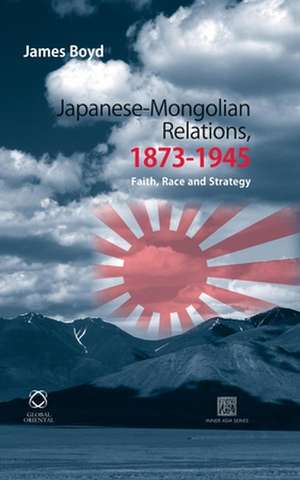Japanese-Mongolian Relations, 1873-1945: Faith, Race and Strategy: Inner Asia Book Series, cartea 8
Autor James Boyden Limba Engleză Hardback – 16 dec 2010
Preț: 525.39 lei
Preț vechi: 618.10 lei
-15% Nou
Puncte Express: 788
Preț estimativ în valută:
100.62€ • 103.67$ • 84.29£
100.62€ • 103.67$ • 84.29£
Carte indisponibilă temporar
Doresc să fiu notificat când acest titlu va fi disponibil:
Se trimite...
Preluare comenzi: 021 569.72.76
Specificații
ISBN-13: 9781906876197
ISBN-10: 1906876193
Pagini: 264
Dimensiuni: 137 x 213 x 20 mm
Greutate: 0.48 kg
Editura: Brill
Colecția Brill
Seria Inner Asia Book Series
ISBN-10: 1906876193
Pagini: 264
Dimensiuni: 137 x 213 x 20 mm
Greutate: 0.48 kg
Editura: Brill
Colecția Brill
Seria Inner Asia Book Series
Cuprins
Preface; Timeline; Maps and illustrations; Introduction; 1 Soldiers, adventurers and educators: Meiji encounters with Mongolia, 1873-1912; 2 Carpe diem?: The Manchurian-Mongolian Independence Movements, 1912-22; 3 Mongolia's riches: Japanese explorers, entrepreneurs and military opportunists, 1922-31; 4 Inner Mongolia: Japanese military activity and its cultural support, 1932-45; 5 Cultural diplomacy in action: The Zenrin Kyokai in Inner Mongolia, 1933-45; Conclusion; Appendix 1: List of key figures; Appendix 2: List of Mongolian and Chinese Place-names; Bibliography; Index
Notă biografică
James Boyd received his BA in History from the University of Adelaide, South Australia and his PhD from Murdoch University, Western Australia. He has held various positions at institutes in Japan and currently is a research fellow of the Asia Research Centre at Murdoch University. His publications include ‘In Pursuit of an Obsession: Japan in Inner Mongolia in the 1930s’, Japanese Studies, ‘A Forgotten “Hero”: Kawahara Misako and Japan’s Informal Imperialism in Mongolia during the Meiji Period’, Intersections and ‘Horse Power: The Japanese Army, Mongolia and the Horse, 1927-42’, Japan Forum.
Recenzii
"... The strength of Boyd’s study is its broad coverage of the full range of Japanese figures active in Inner Mongolian affairs. Parts of this story have been told in English, but the whole has not been surveyed before. Specialists in Inner Mongolia, as well as students of Japan’s informal and formal empires on the Asian mainland, will find this survey
extremely handy..."
Christopher P. Atwood, Asian Studies Review, 2013, Vol. 37, No. 1
"... The most intriguing apsect of Dr Boyd's book is the Japanese perception that its 'relationship with Mongolia [was]... a special one.' (p. 8) The Japanese had a romantic view of their identification with Mongolia, stretching back to Mongolia's prehistory as a fountainhead of Japanese culture. Historians bolstered these links by pointing to the shamanism and Buddhism that both shared, and some nationalists bizarrely claimed that Minamoto no Yoshitsune had not died in his 1189 conflict with his brother but had simply fled to the mainland and assumed the name 'Chinggis Khan'.
In short, Dr Boyd's book adds to the relatively few works on early-modern and modern Northeast Asia."
Morris Rossabi, Journal of the Royal Asiatic Society (JRAS), 21:4, (November 2011)
extremely handy..."
Christopher P. Atwood, Asian Studies Review, 2013, Vol. 37, No. 1
"... The most intriguing apsect of Dr Boyd's book is the Japanese perception that its 'relationship with Mongolia [was]... a special one.' (p. 8) The Japanese had a romantic view of their identification with Mongolia, stretching back to Mongolia's prehistory as a fountainhead of Japanese culture. Historians bolstered these links by pointing to the shamanism and Buddhism that both shared, and some nationalists bizarrely claimed that Minamoto no Yoshitsune had not died in his 1189 conflict with his brother but had simply fled to the mainland and assumed the name 'Chinggis Khan'.
In short, Dr Boyd's book adds to the relatively few works on early-modern and modern Northeast Asia."
Morris Rossabi, Journal of the Royal Asiatic Society (JRAS), 21:4, (November 2011)













